By Eduardo Morales Casas
We conducted this trial to observe antifungal resistance
Did you know that fulvic acid and amino acid 60% application in broccoli and cauliflower are capable of providing enhanced antifungal resistance?
We conducted this trial to observe antifungal resistance in two varieties of Brassicas: broccoli and cauliflower, in the Ferti-Organic experimental field, in Brownsville, TX, during the autumn-winter planting period. The trial lasted 110 days, observing high humidity in the environment, which was not conducive to good plant development and was conducive to fungi proliferation.
Two types of fertilization were used: one 100% organic, and the other 70% organic and 30% traditional or chemical. Two foliar treatments were carried out, the first with fulvic acid application and the second with fulvic and amino acids 60% in a proportion of 50% each, according to the application tables. The results were compared and contrasted both when applying fulvic acid and the combination of fulvic acid and amino acids, observing better results and greater antifungal resistance with the application of both.
The objective of this trial is to prove that the joint application of fulvic and amino acids helps to prevent stress in plants, either by biotic and abiotic factors caused by pathogenic fungi of economic importance in Brassicas cultivation.
Brassicas Cultivation
The central hypothesis of this study is to find if there is a statistical and physical difference between fulvic acid application and the combination of fulvic acid with amino acids 60%. Both broccoli and cauliflower are crops that belong to the Brassicas or cruciferae family. In both, the edible part is the immature inflorescence found in the central part of the stem, known as the head or curd.
They are vegetables of great nutritional value for humans due to their high vitamin A, C, complex B and iron content, in addition to being rich in potassium and fiber, significantly reducing the risk of contracting diseases.

Image 1. Cauliflower sample. Trial at the Ferti-Organic experimental field, Brownsville, TX.
Photo credit: Morales, E. (2021).
Broccoli
It adapts to cold to temperate temperatures, its best performance being between 15 and 25ºC, withstanding cold temperatures of up to -2ºC when the inflorescence has not yet appeared. Very high temperatures cause uneven heads, smaller in size and purple in color. It is tolerant to soils with high salinity.

Image 2. Broccoli sample. Trial at the Ferti-Organic experimental field, Brownsville, TX.
Photo credit: Morales, E. (2021).
Cauliflower
It requires temperatures between 15 and 20ºC, although it can withstand frost, but not freezing temperatures, especially before inflorescence (head). High temperatures can cause it to appear yellowish and loose. It is tolerant to acid soils, its optimum range being between 6.5 and 7.5 pH.
Sowing
These two crops are transplanted about 30 days after being planted in trays, when the seedlings have four to five true leaves. The distance between plants is 12 to 16 inches, one or two rows, achieving densities of 30,000 to 55,000 plants per hectare, even reaching up to 80,000 plants in some plantations. These crops should be transplanted in the morning or very late, to avoid stress on the plants.
The broccoli and cauliflower root system does not deepen beyond 12 inches, which is why watering should be very light and frequent, avoiding long periods of drought, since inflorescence can take place earlier.

Image 3. Sowing view. Trial at the Ferti-Organic experimental field, Brownsville, TX.
Photo credit: Morales, E. (2021).
Main Fungal Diseases in Broccoli and Cauliflower
During the summer, warm conditions and high relative humidity favor the presence of diseases. Broccoli and cauliflower are among the vegetables with the highest susceptibility to diseases, mainly attacking their leaves, flowers and roots; they can occur during plant growth and development causing the roots to rot, foliar malformations and yield reduction. Some of the diseases that occur in broccoli and cauliflower are
- Black spot (Alternaria brassicae)
- Gray Mold (Botrytis cynerea)
- Downy Mildew (Peronospora parasitica)
- Black Foot (Phoma lingam)
Black Spot
Black spot is caused by the fungus Alternaria brassicae. This fungus, together with A. brassicicola, is one of the species that causes the greatest issues in cruciferous crop production, especially due to its ability to survive in seeds for several months, at different temperatures and relative humidity.
Gray Mold
The diseases caused by Botrytis cynerea are perhaps the most common in vegetables since they appear in the form of inflorescence blights and fruit rots, but also as stem cankers or rots, drowning of seedlings, leaf spots and tuber rots. This fungus survives in high relative humidity conditions, because it produces a conspicuous fruiting layer of gray mold that stands out on the affected tissues, as shown in image 4.
Downy Mildew
Downy Mildew occurs on the underside of young leaves, where black spots can be seen, while irregular spots of the same color or yellowish spots are visible on the upper side of the leaf. On older leaves, lesions grow rapidly and may coalesce, ending up in large, sunken, paper-colored spots. When the leaves are wet, growth occurs on the underside.
Black Foot
Black Foot is caused by the fungus Phoma lingam, mainly occurring in cold climates and very humid soils, causing stem tissue rots \in young plants, their leaves losing their normal green color and plant growth stalling, until it finally dies. Severe stem infections result in dark, dry rots above the soil line, as shown in Figure 4, from which the name “Black Foot” derives. The lesions surround the stem causing infected plant wilting.

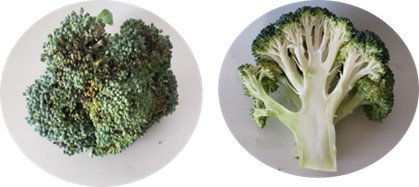
Image 4. Diseases caused by fungi.
Photo credit: Morales, E. (2021).
Fulvic Acids
Fulvic acids constitute a series of solid and semi-solid amorphous compounds, yellowish in color and colloidal in nature, easily dispersed in water and are not precipitable by acids.
The natural benefit of fulvic acids in plants, either by direct application to the soil or by foliar application, is the increased resistance to biotic and abiotic agents, such as resistance to diseases and stress conditions like drought, frost and attacks of certain pests, which can only be achieved through continuous applications. In addition, in the metabolic system of plants, fulvic acids provide enhanced respiration, increased protein metabolism and the activity of multiple enzymes, enhancing the permeability of cell membranes, cell division and elongation. They are also very important in chlorophyll synthesis.
As for the direct effects on the soil, fulvic acids are necessary to stabilize soil pH, assist nitrification by bacteria fixation and contribute to the electrochemical balance of both the donor and the recipient. They also have action on silica in terms of its assimilation, helping the release of some essential minerals and having a detoxifying action on the soil, mainly from pesticides and herbicides.
The main benefits obtained by applying fulvic acids are:
- Stimulate overall plant growth.
- Perfect nutrient and agrochemical absorption and translocation, both in foliar application and to the soil or root.
- Enhance soils by promoting microorganism reproduction.
- Act as biostimulants and catalysts for biochemical processes in plants and the formation of nucleic acids, due to their high amino acid content.
- Perform chelating actions and make the nutrient that is difficult to absorb available to the plant.
- Stimulate the development of pesticide- and herbicide-degrading microorganisms that usually settle in the soil for a long time.
Amino Acids
They are molecules composed of peptides and proteins of great importance, produced by plants. Amino acids are synthesized normally, fulfilling various plant functions, such as the enhanced nitrogen absorption, the chelating effect of some amino acids such as L-proline and the antioxidant activity of L- glycine betaine and proline. Its use in crop biostimulation is currently mainly aimed at mitigating biotic and abiotic stress.
Amino acids are the most difficult substances for the plant to produce, intervening in several vital processes such as the recovery of plants that have been subjected to some type of stress, given that when a plant is under stress, it avoids producing these substances that consume a lot of energy and concentrates them at the points it needs, via the phloem.
Materials and Methods
In the Ferti-Organic experimental field, located in Brownsville, TX, four rows were traced, each 25 ft long, with a population of 105 plants per row, planting two rows of cauliflower and two rows of broccoli, with two different fertilizations according to laboratory recommendations and one fertilization with compost and organic biofertilizers 100% and the other with compost and biofertilizers 70%. Chemical products such as MAP, ammonium sulfate and 100% soluble ICL products were used for the remaining 30%. With respect to the foliar treatment, two treatments and one control were applied.
- Treatment 1: only with fulvic acids.
- Treatment 2: with fulvic acids and amino acids 60%, in a proportion of 50% each and according to Ferti-Organic product recommendations, as shown in the table below.
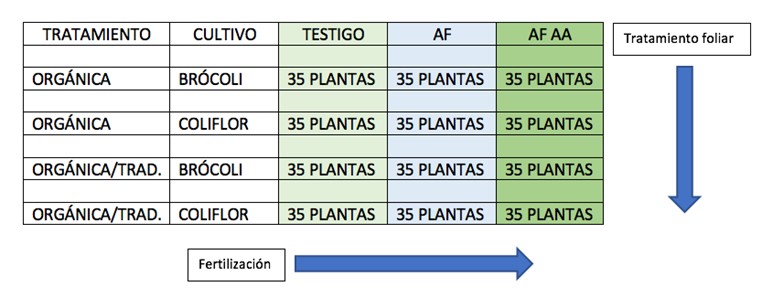
Table 1. Treatment table.
Source: Personal Research (2022).
Two varieties of seeds were used: Belstar broccoli and Skywalker cauliflower.
Belstar Broccoli
It is an organic hybrid for spring and summer plantings that has proven to be widely adapted. It has performed particularly well in Florida and Texas in the winter. Heads are medium green and well-domed with a medium-size bead. It produces strong, stress-tolerant plants with good side-shoot production. Ideal for summer and fall harvest. It is organic and USDA-certified.
Skywalker Cauliflower
It is undoubtedly the best organic variety for late summer and fall harvests. It presents uniform, medium-size, and self-wrapping heads. Large, healthy plants. Cold tolerant. Ideal for winter in South Texas and Florida. [USDA]-certified organic
Characteristics of Fulvic Acid to be Used
Fulvic Acid is a concentrate derived from plant residues. This high-efficiency, multi-functional fertilizer is ideal to aid plant uptake of micronutrients. It is compatible with most liquid fertilizers, pesticides, herbicides and defoliants. It possesses the same characteristics and benefits of Fulvic Acid 90% with a lower 70% concentration (Ferti-Organic).
Characteristics of Amino Acids 60% to be Used
Amino Acid 60% is a biofertilizer in powder, produced enzymatically and derived from soy protein, with a guaranteed minimum of 14% of plant-available nitrogen.
Ferti-Organic Amino Acid 60% contains amino acids and short polypeptides readily available for nutrient uptake and absorption.
It is highly recommended for organic agriculture as it is rich in protein hydrolysates, which stimulate carbon and nitrogen metabolism and increase nitrogen assimilation in plants.
It is suitable for application on field crops, potting soil, vegetable and flower gardens, orchards and turf grass.
Soil Characteristics
The soil conditions of the Ferti-Organic experimental field show a poor soil of 1.30% in organic matter, the nitrogen content is marginal at 47 lb/acre, phosphorus is 8 lb/acre and potassium is 52 lb/acre, both of which are very low.
Climate
During the trial process and development, the following average climate characteristics were observed in the area:
| Temperature | 19.70ºC |
| Dew Point | 13.87ºC |
| Humidity | 71.67% |
| Wind | 13.49 mph |
| Atmospheric Pressure | 1017.32 mmHg |
| Precipitation | .470 mm |
The climate characteristics shown are good; however, the relative humidity is higher than desirable, this being 50 to 60%. It should be noted that, during the process, there were days greater than 80%, with an average humidity of 71.67%, which is a suitable humidity for fungi and bacteria proliferation, a condition that is added to a highly humid environment that inhibits the soil nutrient absorption.
Measurements
For the purposes of this trial, measurements were carried out at 20, 35, 50 and 65 days following transplant, determining the parameters below:
- NO3– concentration expressed in ppm.
- K+ concentration expressed in ppm.
- Na+ concentration expressed in ppm.
- Ca+ concentration expressed in ppm.
The instruments used to measure were HORIBA LAQUAtwin and brixx meter.
Head circumference, weight and hardness were measured. Physically, the amount of fungi that affected the plants was evaluated to determine whether or not there is a presence of fungi.
Graph 1 shows the complete measurement process in time, nutrient mobility in the two types of fertilization, measurement dates and treatment application dates.
Four applications were made, the first 20 days after transplant and three more every 15 days. Applications were in accordance with the manufacturer’s recommended application rates that, for fulvic acids, requires a proportion of 3 kg/ha in 200 L of water, achieving a concentration of 1.47% and, for amino acids, of 4 kg/ha in 200 L of water, achieving a concentration of 1.96%. These applications were made using a 4-gallon manual backpack sprayer.
Harvest days began between 75 and 85 days, where heads were measured and disease-infected and healthy plants were observed.
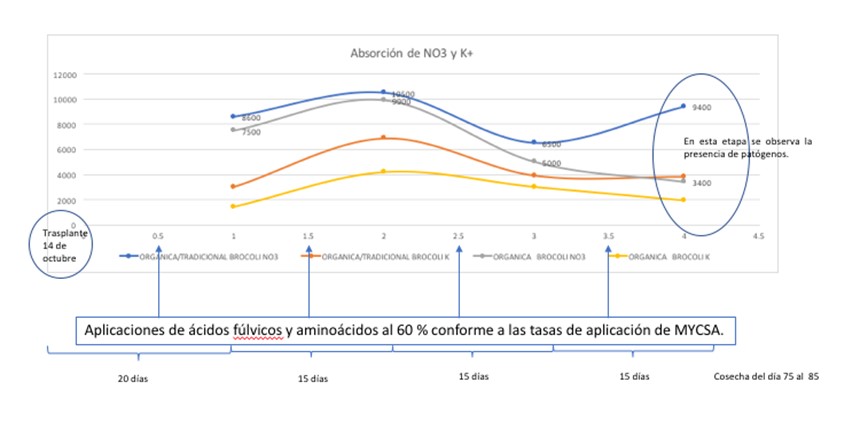
Graph 1. Complete Measurement Process. Source: Personal Research (2022).
Results
Below are the results of each fertilization, cultivation and foliar treatments. With respect to 70% organic fertilization and 30% traditional or chemical products, enhanced resistance was observed compared to 100% organic fertilization. In both cases, the treatment of fulvic acids and amino acids 60% achieved optimal results when applying the mixture of both. These results are shown in the graphs below.

Table 2. Broccoli. 100% organic fertilization.
Source: Personal Research (2022).

Table 3. Cauliflower. 100% organic fertilization.
Source: Personal Research (2022).
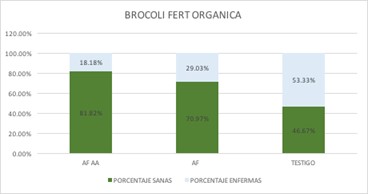
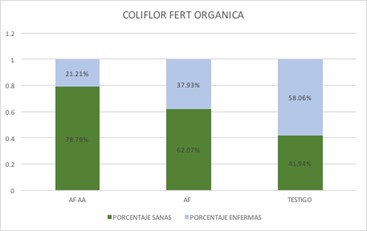
Graph 2. 100% organic broccoli and cauliflower fertilization. Percentage of healthy and diseased-infected Brassicas.
Source: Personal Research (2022).

Table 4. Broccoli. 70% organic and 30% traditional or chemical fertilization.
Source: Personal Research (2022).

Table 5. Cauliflower. 70% organic and 30% traditional or chemical fertilization.
Source: Personal Research (2022).
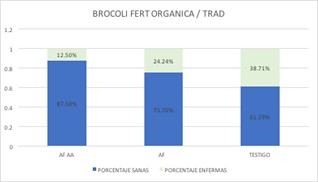
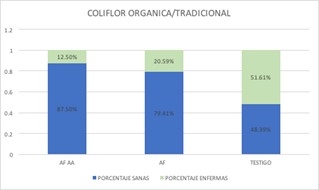
Graph 3. 70% organic and 30% traditional or chemical fertilization of broccoli and cauliflower.
Percentage of healthy and disease-infected Brassicas.
Source: Personal Research (2022).

Image 5. Disease-infected broccoli.
Photo credit: Morales, E. (2021).
Conclusions
We can affirm that there is a major statistical difference between treatments, optimal results being 70% organic fertilization, to which a chemical product support is added for enhanced performance.
The foregoing represents more benefits than 100% chemical or traditional fertilization, given the abuse of nitrogenous fertilizers, while 70-30 fertilization has a positive impact on the soil care and healthier crops.
There is undoubtedly greater sensitivity to fungal attack with 100% organic fertilization.
By only applying fulvic acids, antifungal resistance is noted, probably due to greater plant nutrient mobility.
When attacked by fungi, plants fertilized only with organic products lose their ability to absorb nutrients and become more susceptible to attack by these pathogens.
Antifungal resistance is much greater by applying the mixture of fulvic acid and amino acids, thereby proving that amino acids help to synthesize faster the proteins that the plant needs to withstand biotic and abiotic stress situations. The mixture of amino acids with fulvic acids seeks a better use of nutrients both in the soil and in the nutrient solution.
References
Álvaro, G.J. (2019). Ácidos húmicos y fúlvicos. Fertibox Agricultural Analysis. https://www.fertibox.net/single-post/acidos
Cerisola, C. (2015). La materia orgánica edáfica. Manejo y conservación de suelos. Argentina: Department of Environment and Natural Resources. UNLP.
Johnny’s Selected Seeds. (2022). Belstar, semilla de brócoli orgánico (F1). Producer’s Library. https://www.johnnyseeds.com/vegetables/broccoli/standard-broccoli/belstar-organic-f1-broccoli-seed-2815G.html
Johnny’s Selected Seeds. (2022). Andante del cielo/Skywalker, semilla de coliflor orgánica (F1). Producer’s Library. https://www.johnnyseeds.com/vegetables/cauliflower/skywalker-organic-f1-cauliflower-seed-2593G.html?cgid=cauliflower
Lesur Esquivel, L. (2008). Manual de viverismo. Horticultura ornamental. Una guía paso a paso. Mexico: Trillas.
López Torres, M. (2016). Horticultura. Mexico: Trillas.
Ferti-Organic. (2022). Official site. https://www.ferti-organic.com/
Nutricontrol. (2020). La humedad relativa en el invernadero. Cartagena, Span. https://nutricontrol.com/es/la-humedad-relativa-en-invernadero/#:~:text=La%20humedad%20relativa%20en%20un,se%20pueda%20llevar%20a%20cabo
Preparación de hortalizas. (2018). Mexico: Trillas. Serie de negocios agropecuarios.
Weather Spark. (2021). El clima y el tiempo promedio en todo el año en Brownsville, Texas. https://es.weatherspark.com/y/7911/Clima-promedio-en-Brownsville-Texas-Estados-Unidos-durante-todo-el-a%C3%B1o





 (956) 574-8280
(956) 574-8280 info@ferti-organic.com
info@ferti-organic.com